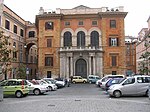Temple of Serapis (Quirinal Hill)
Buildings and structures demolished in the 4th centuryDestroyed templesPersecution of pagans in the late Roman EmpireSerapeumTemples of Isis ... and 1 more
Temples on the Quirinal

The Temple of Serapis on the Quirinal Hill in Rome was an sanctuary in Ancient Rome dedicated to the god Serapis and the goddess Isis.The temple was founded on an unknown date but known to have existed during the reign of Caracalla. It was known as the most monumental temple of the Quirinal Hill. In the 4th century, the temple was closed during the persecution of pagans in the late Roman Empire, after which it was torn down and used as building material.The gardens of the Palazzo Colonna contain what are believed to be the ruins of the Temple of Serapis.
Excerpt from the Wikipedia article Temple of Serapis (Quirinal Hill) (License: CC BY-SA 3.0, Authors, Images).Temple of Serapis (Quirinal Hill)
Via della Pilotta, Rome Municipio Roma I
Geographical coordinates (GPS) Address Nearby Places Show on map
Geographical coordinates (GPS)
| Latitude | Longitude |
|---|---|
| N 41.8983 ° | E 12.4855 ° |
Address
Via della Pilotta
00187 Rome, Municipio Roma I
Lazio, Italy
Open on Google Maps










